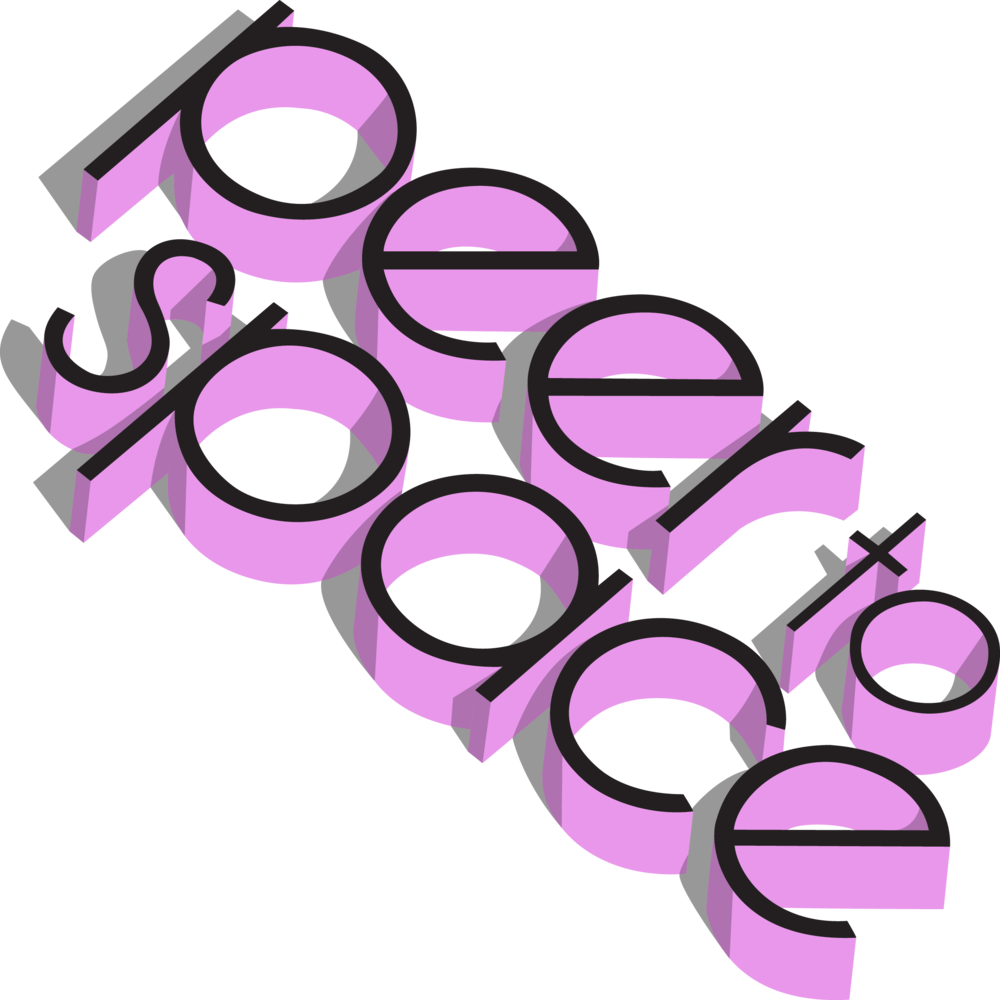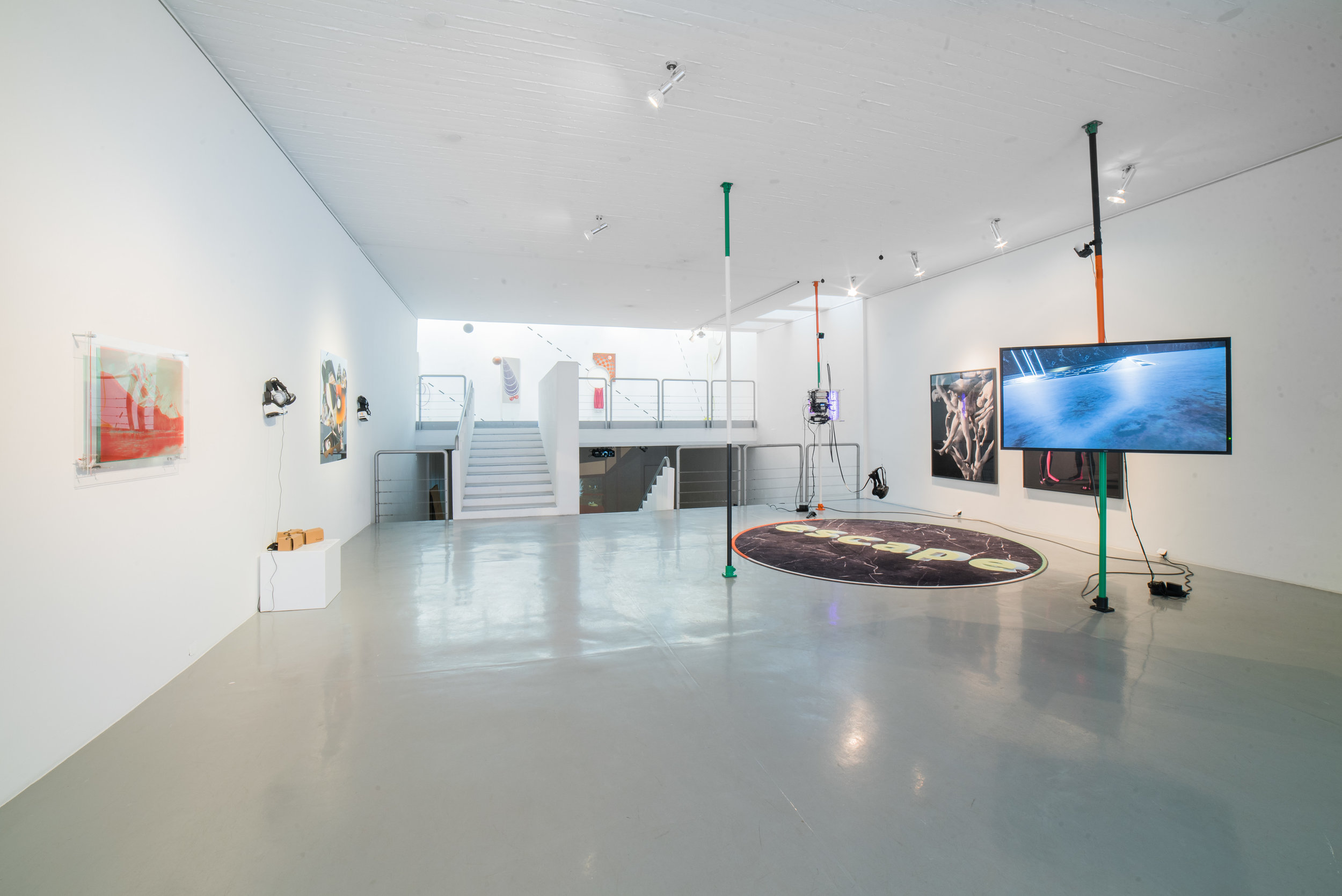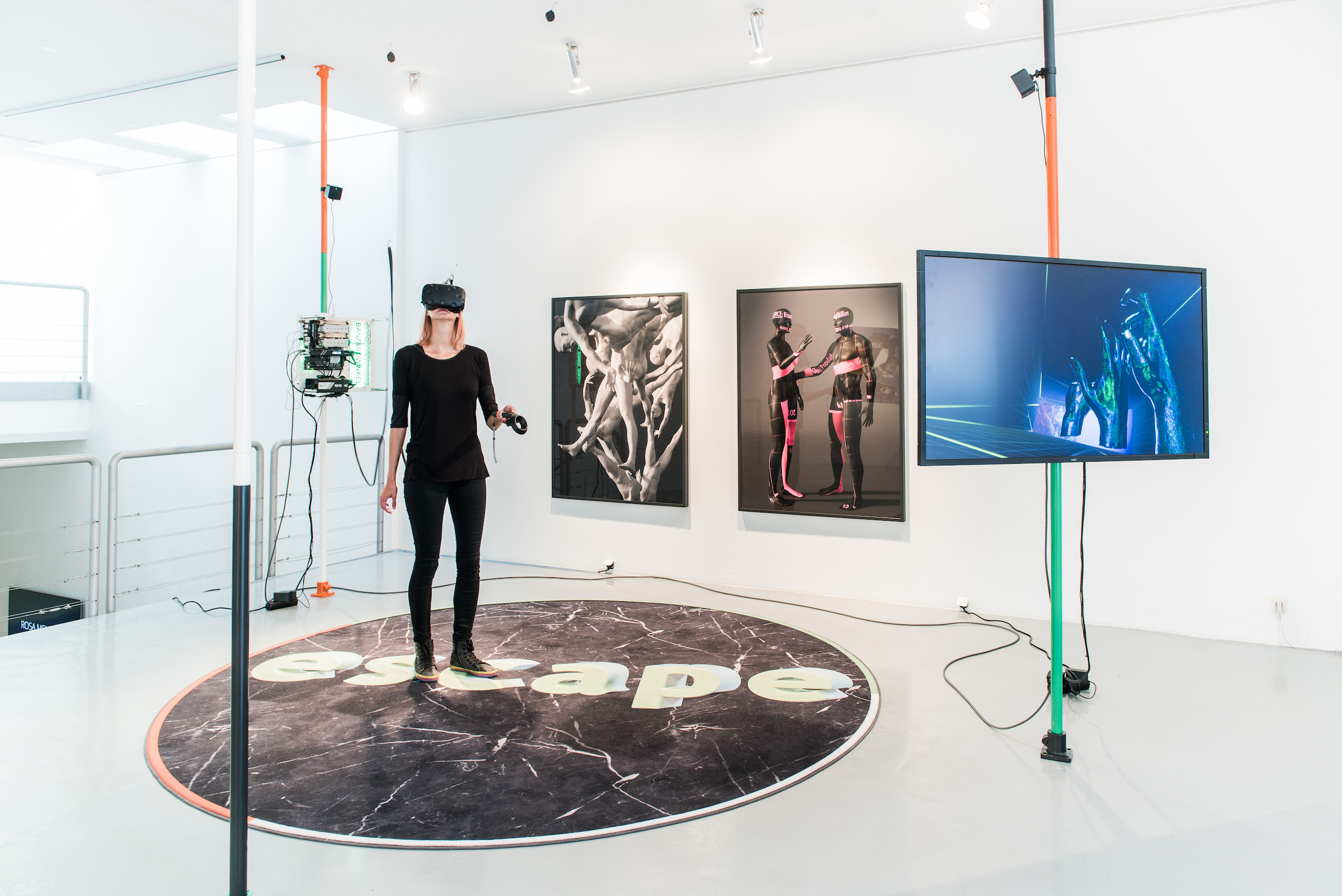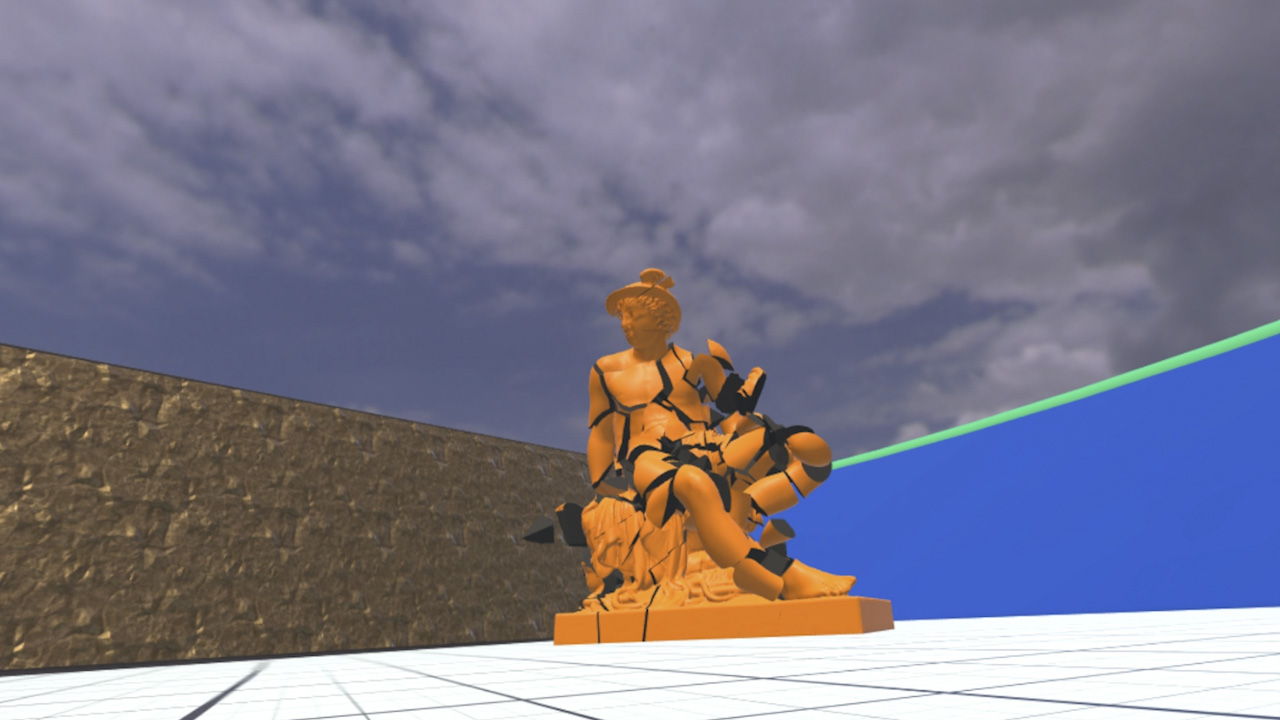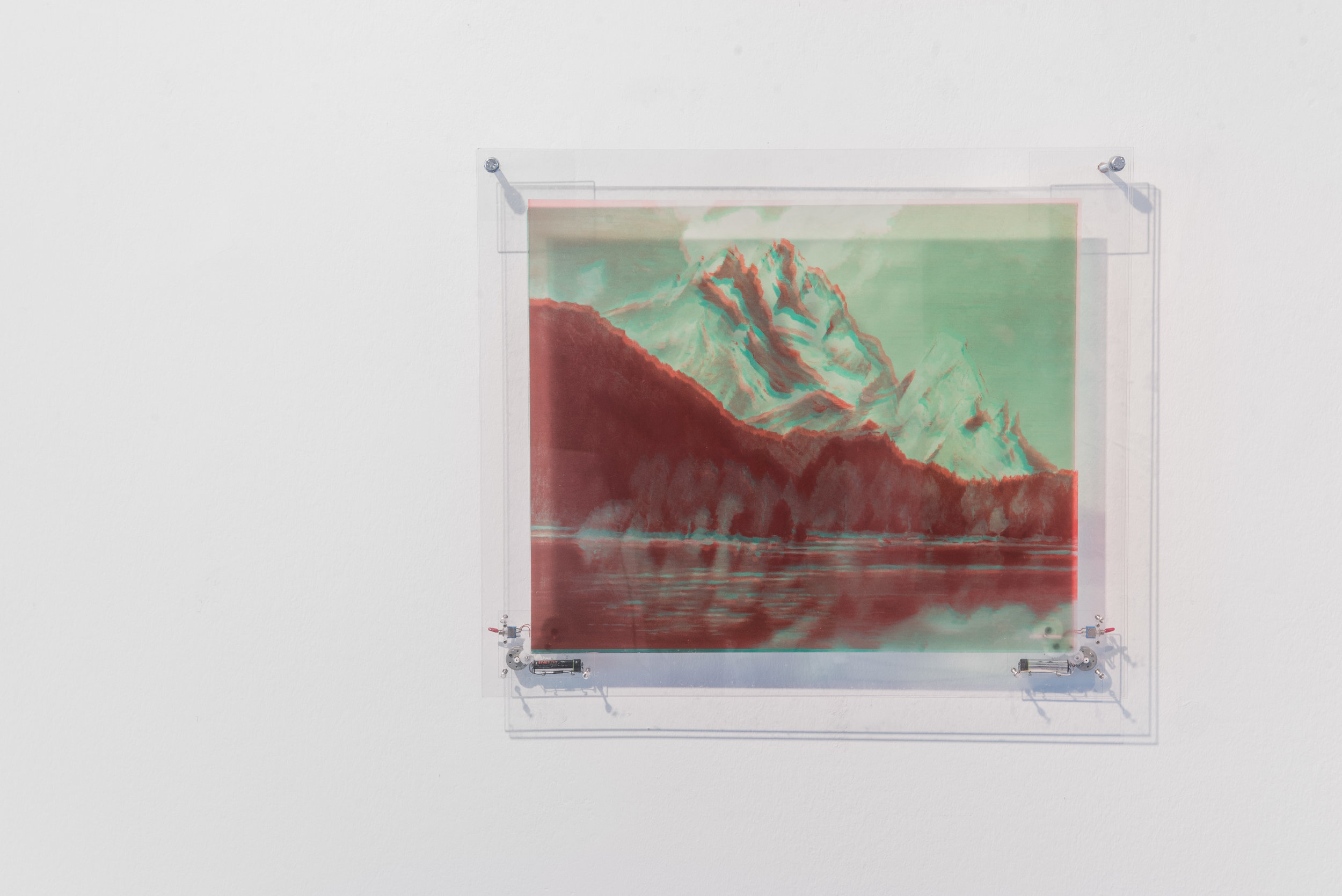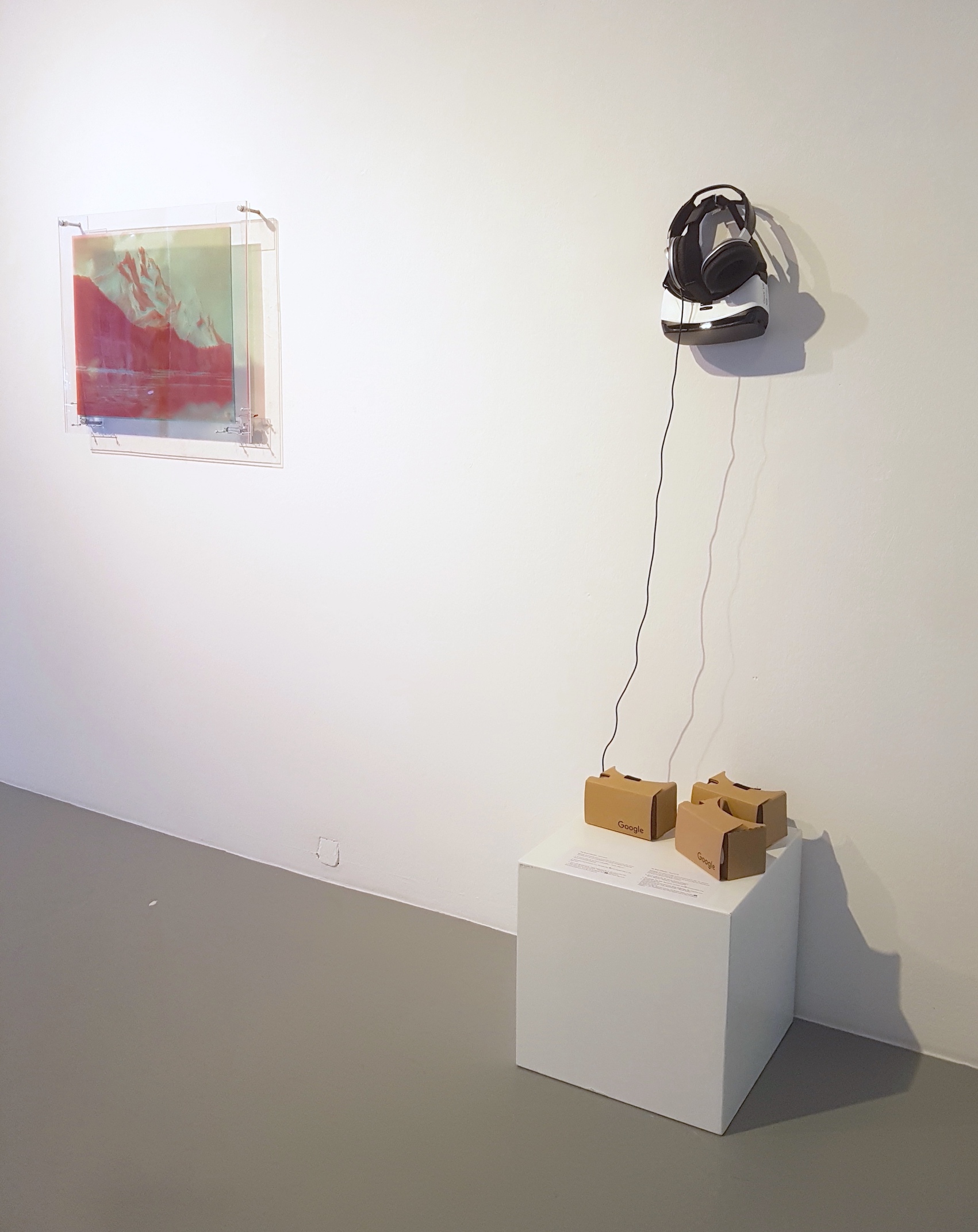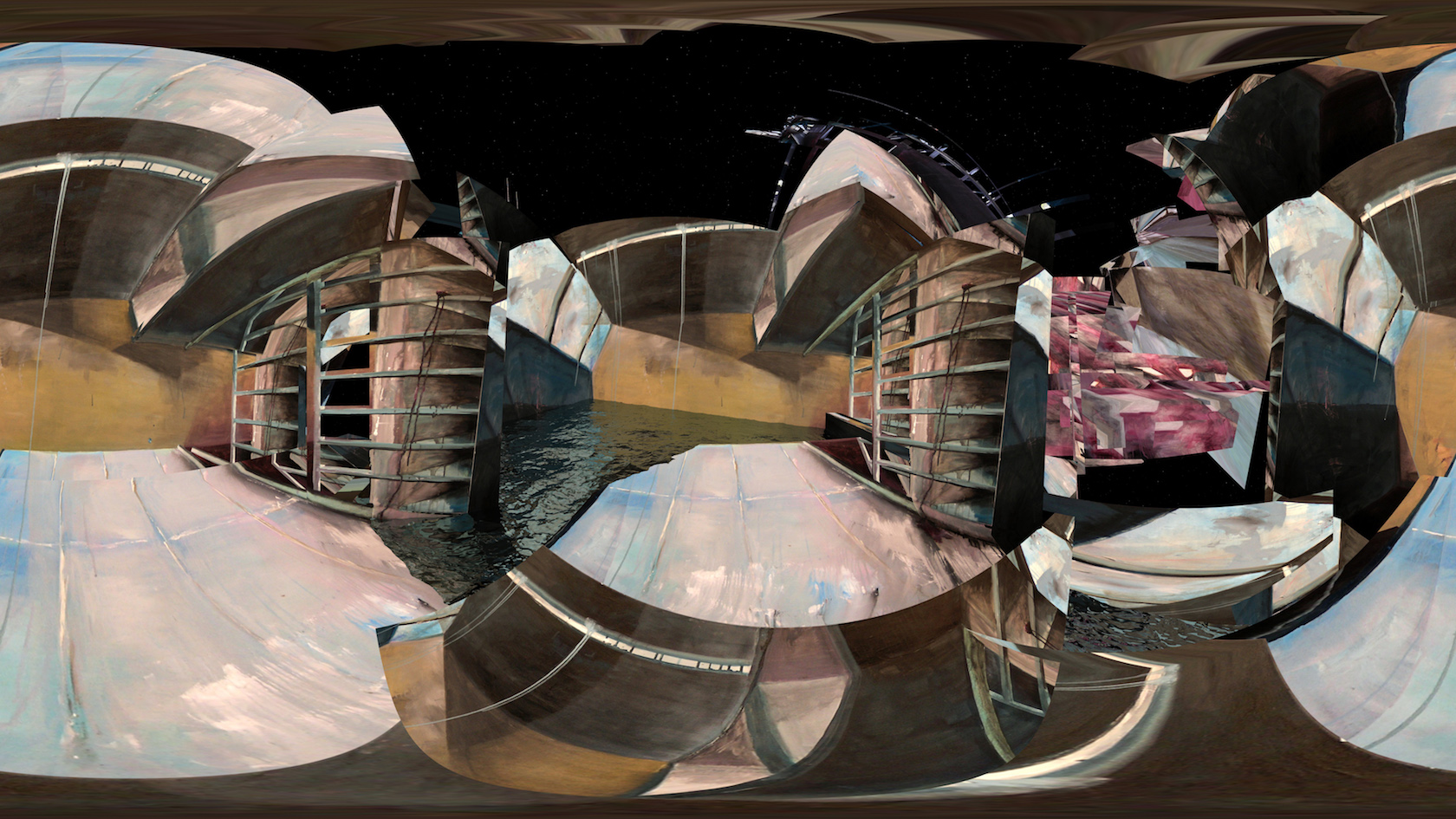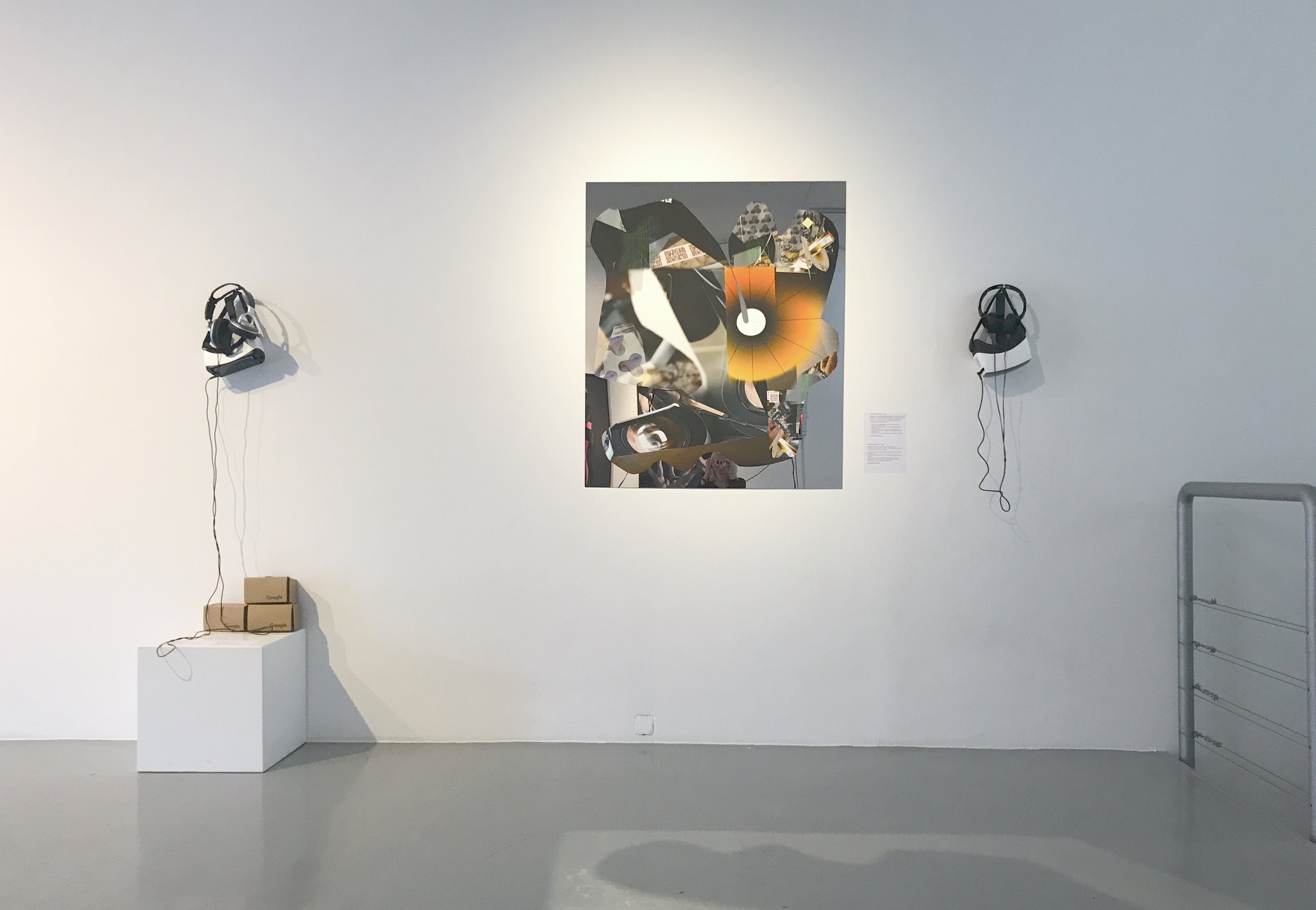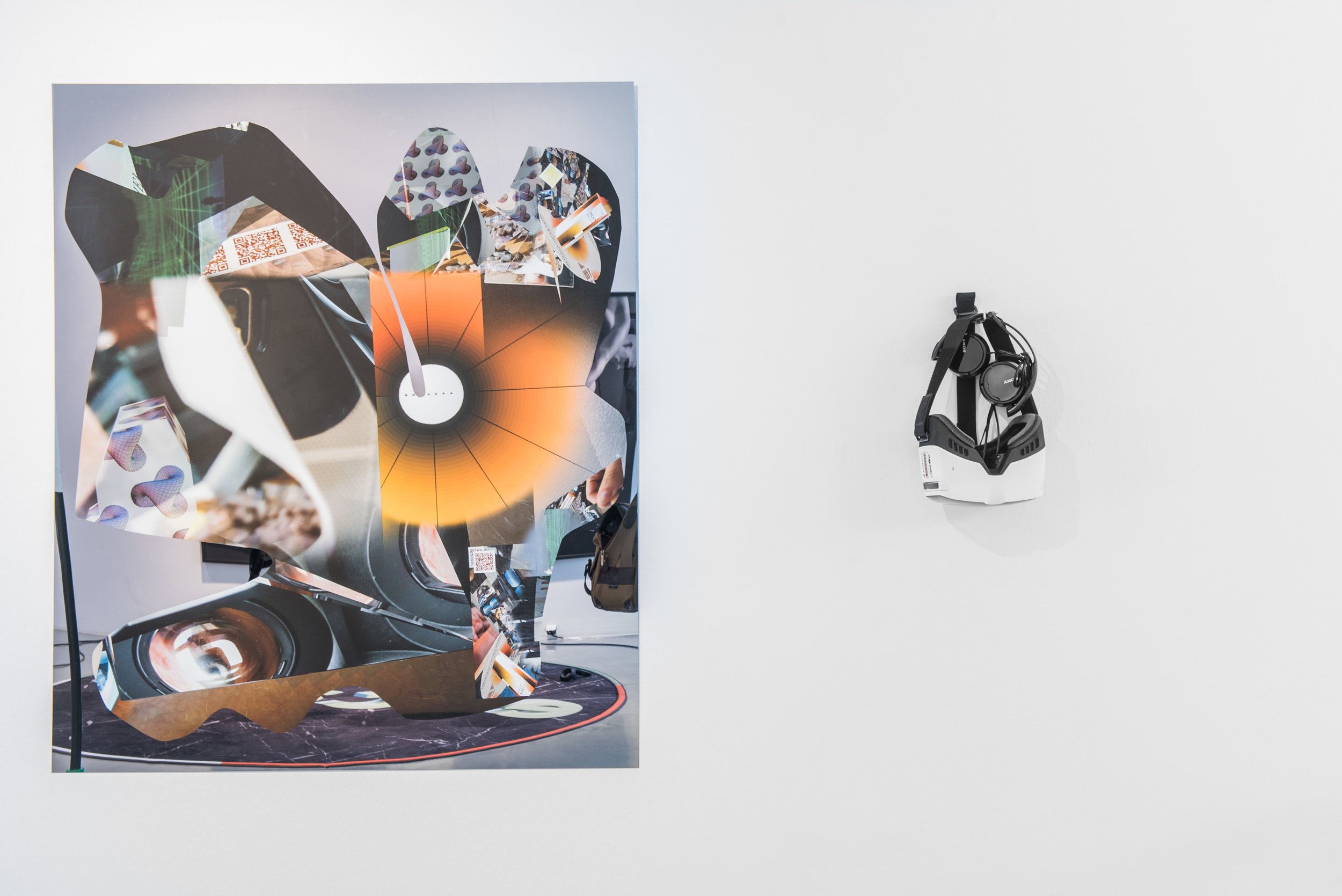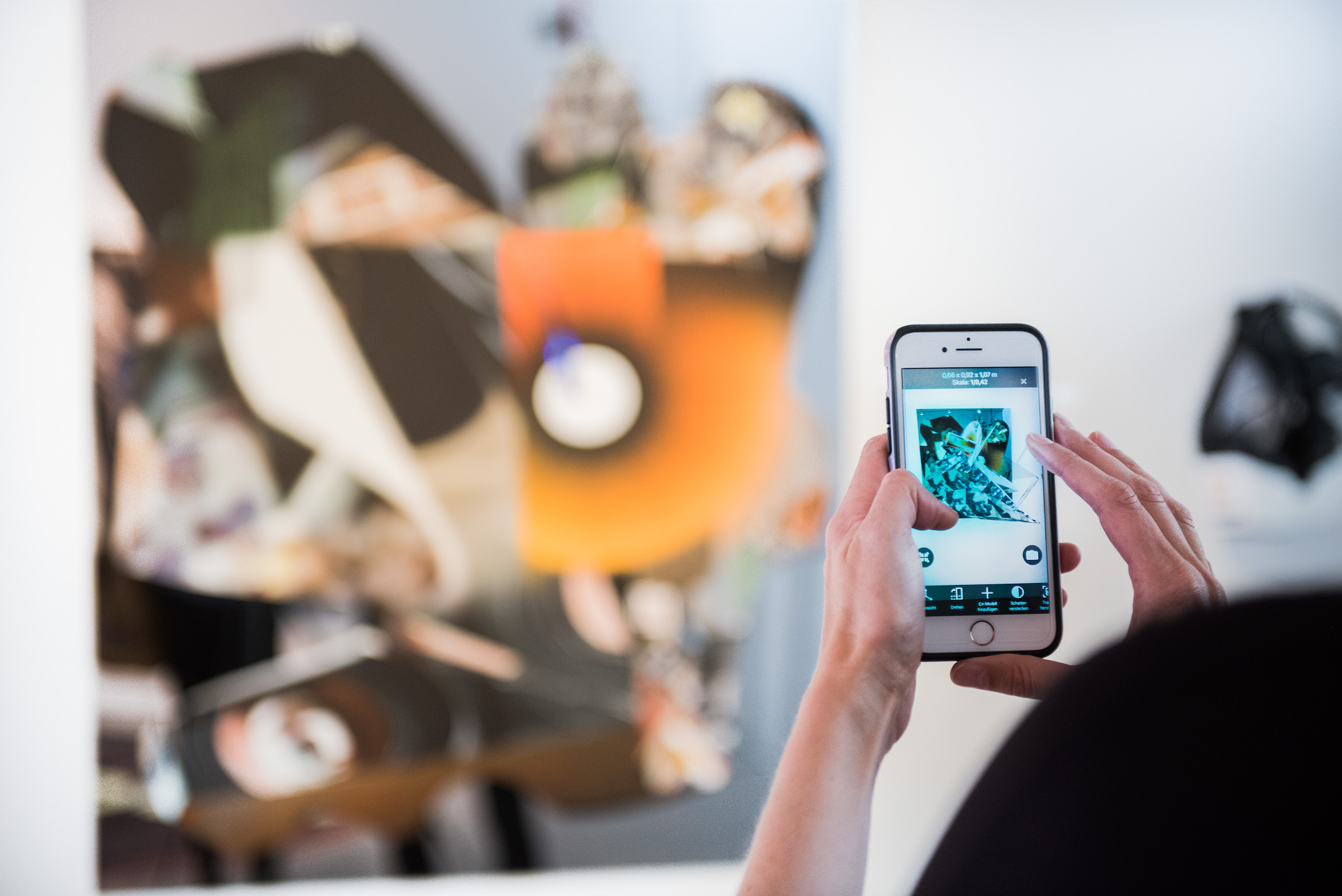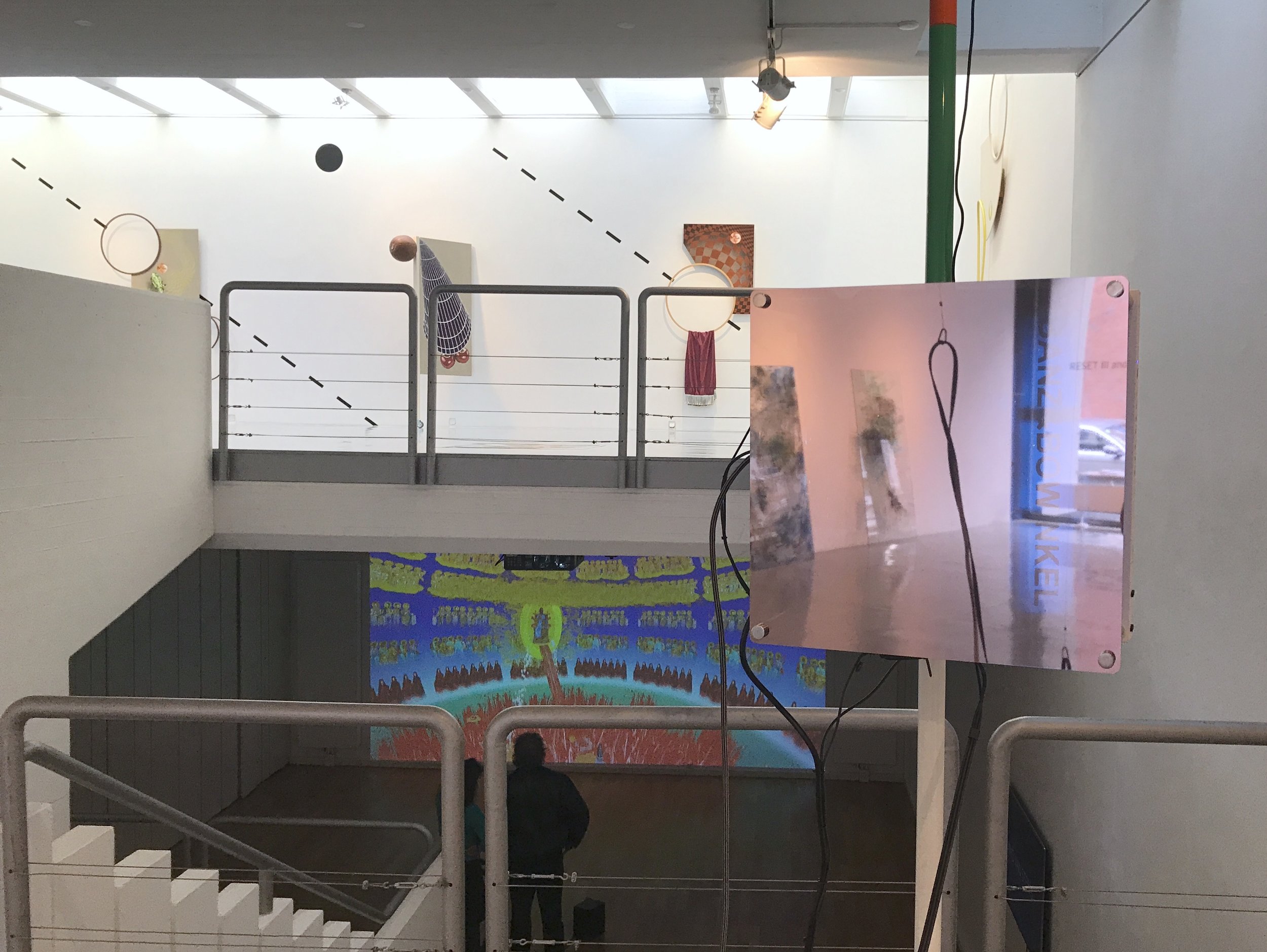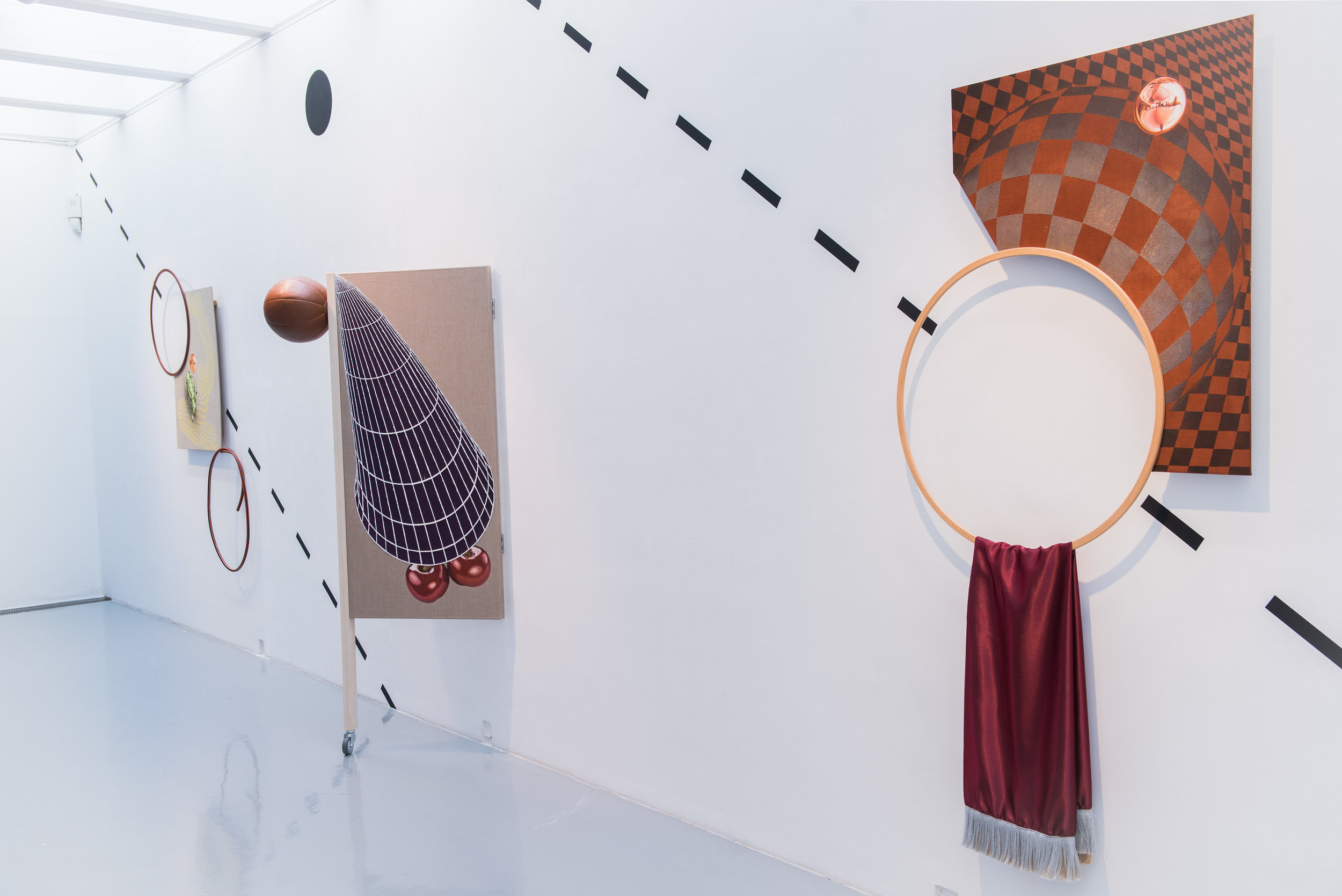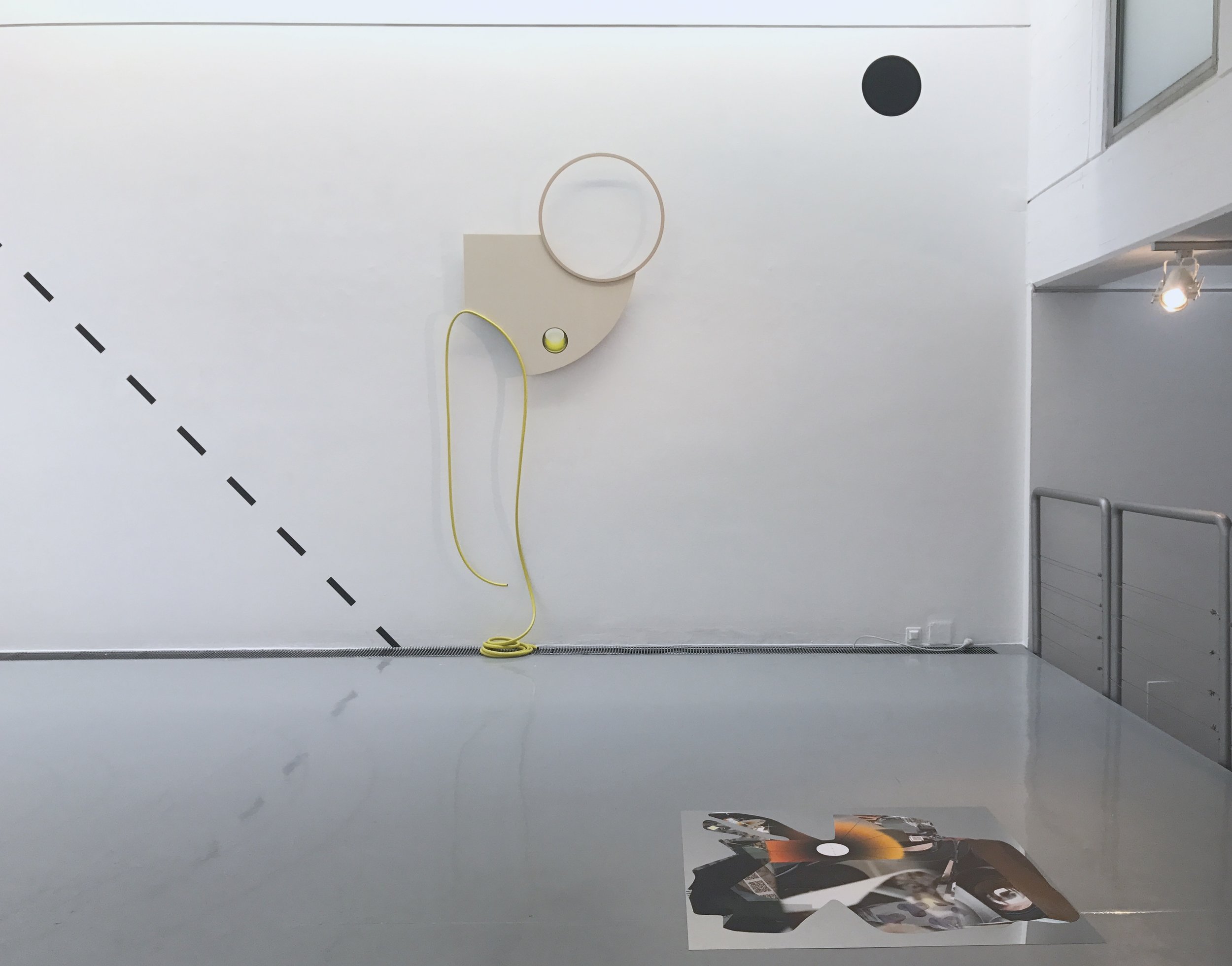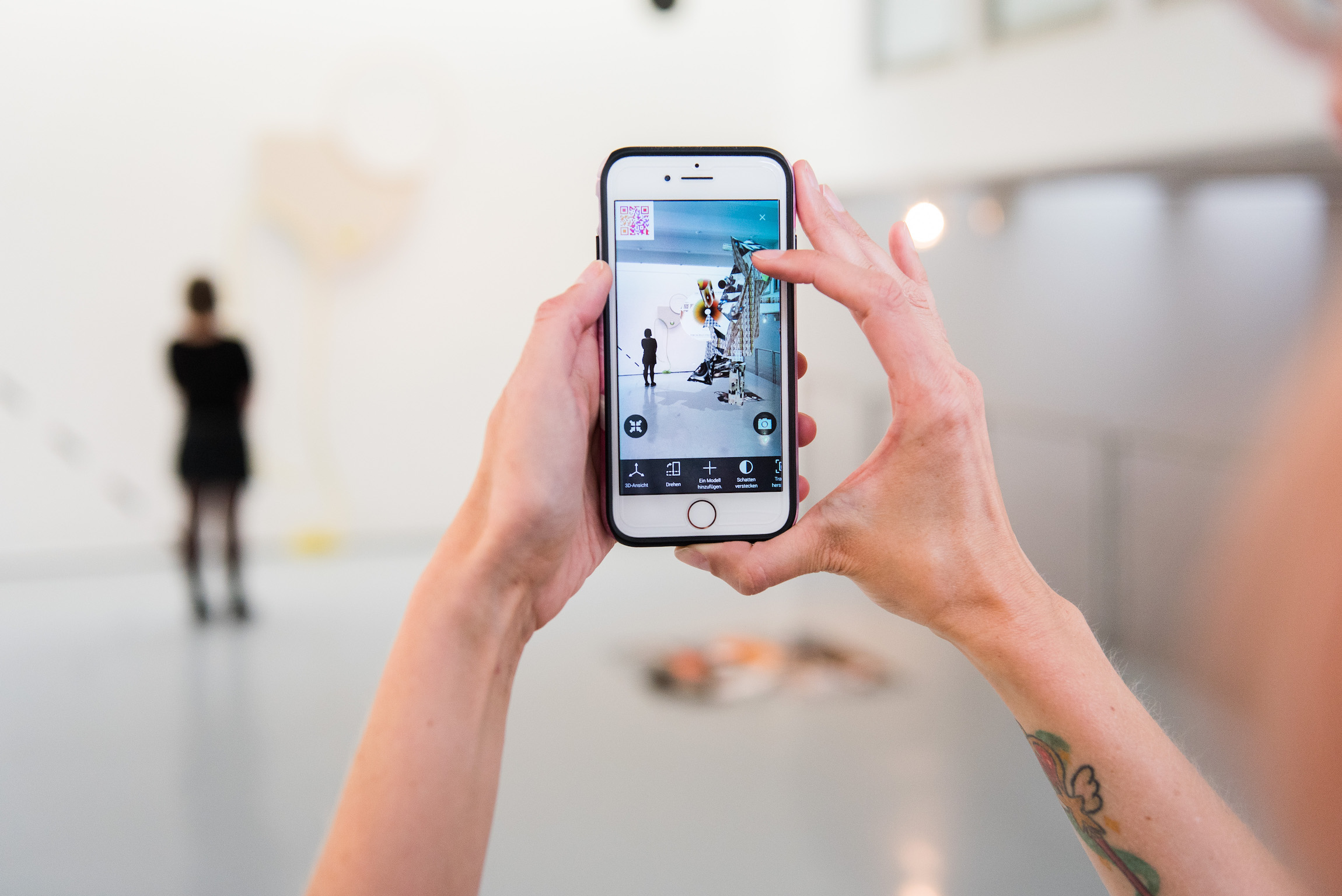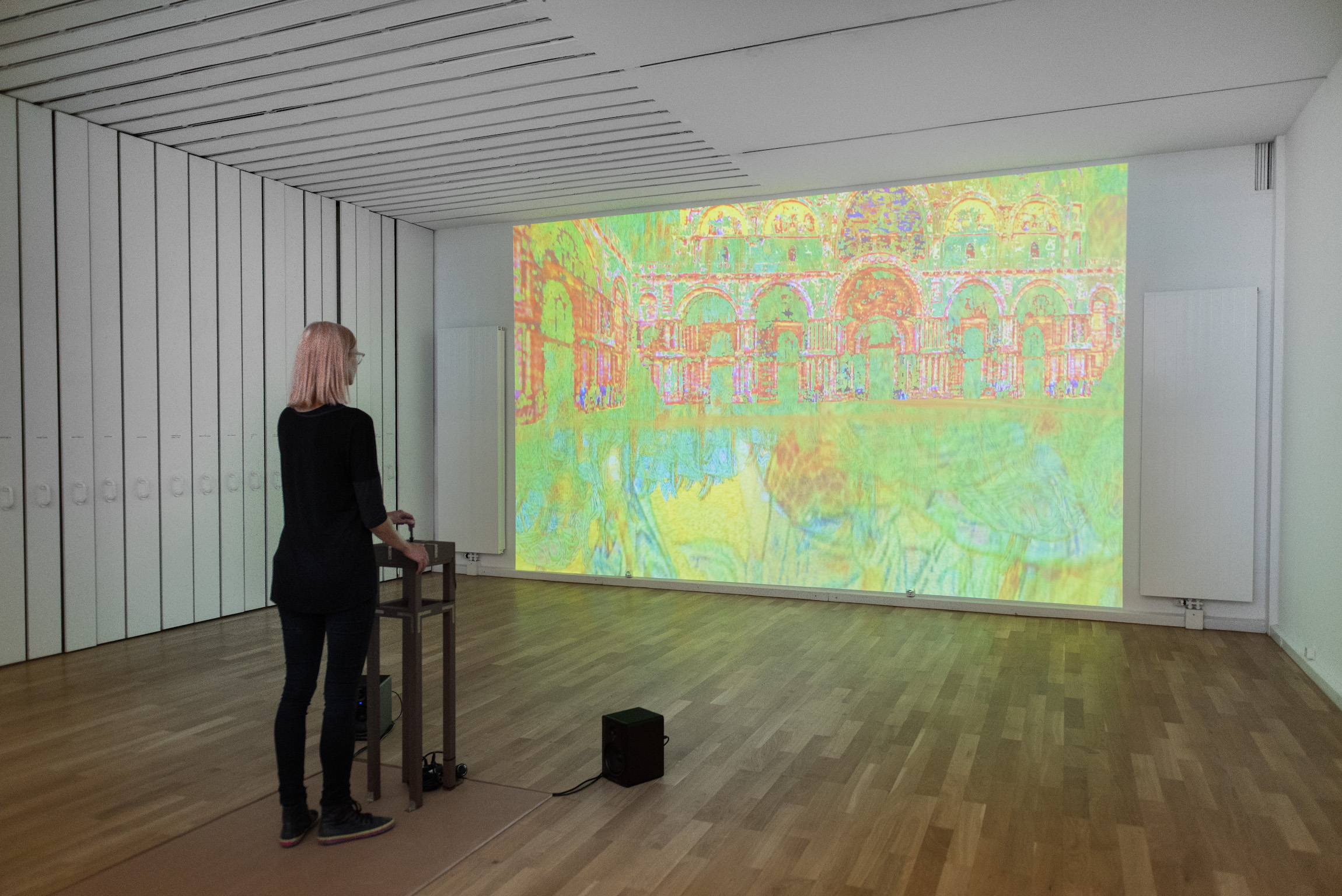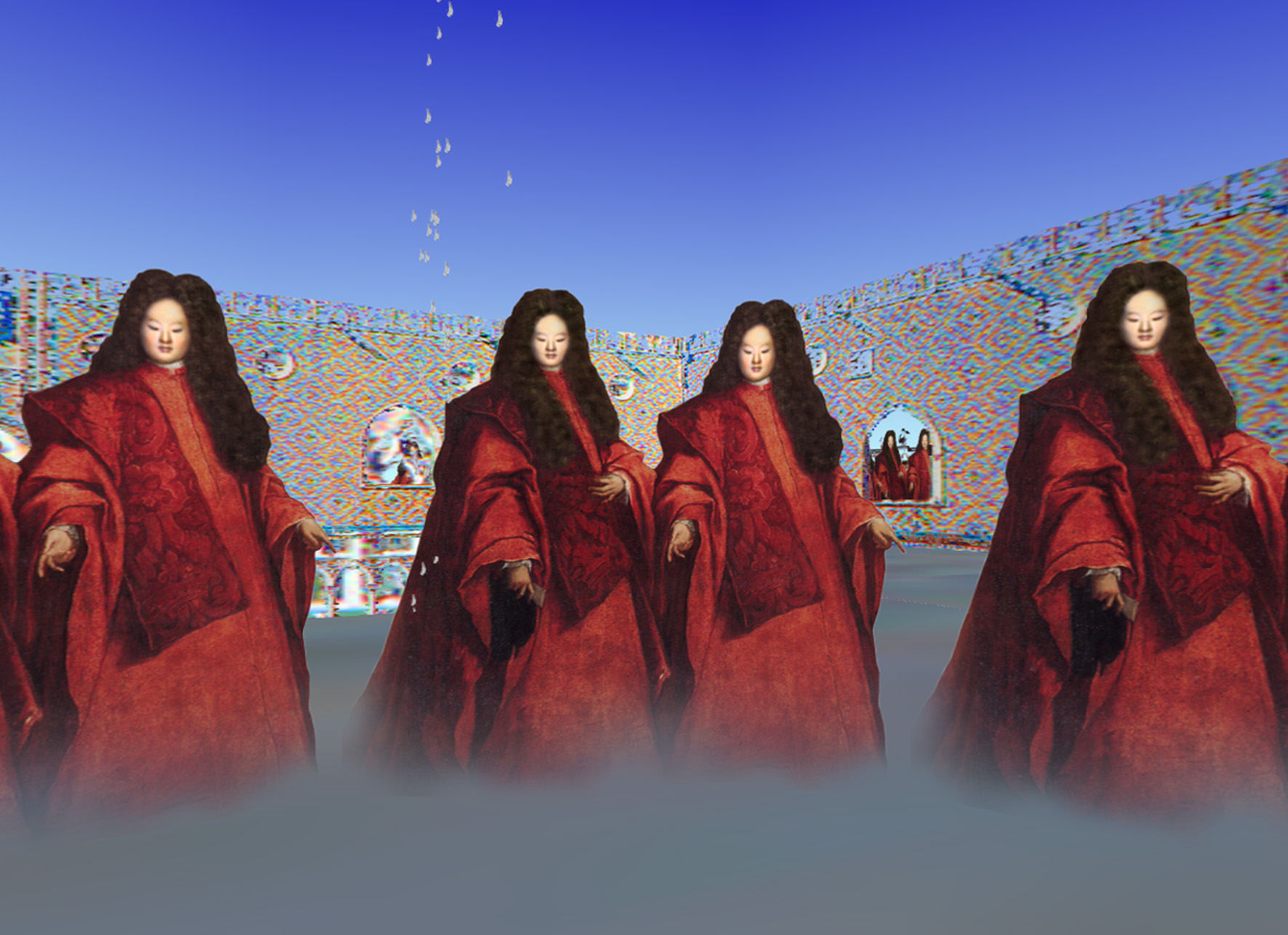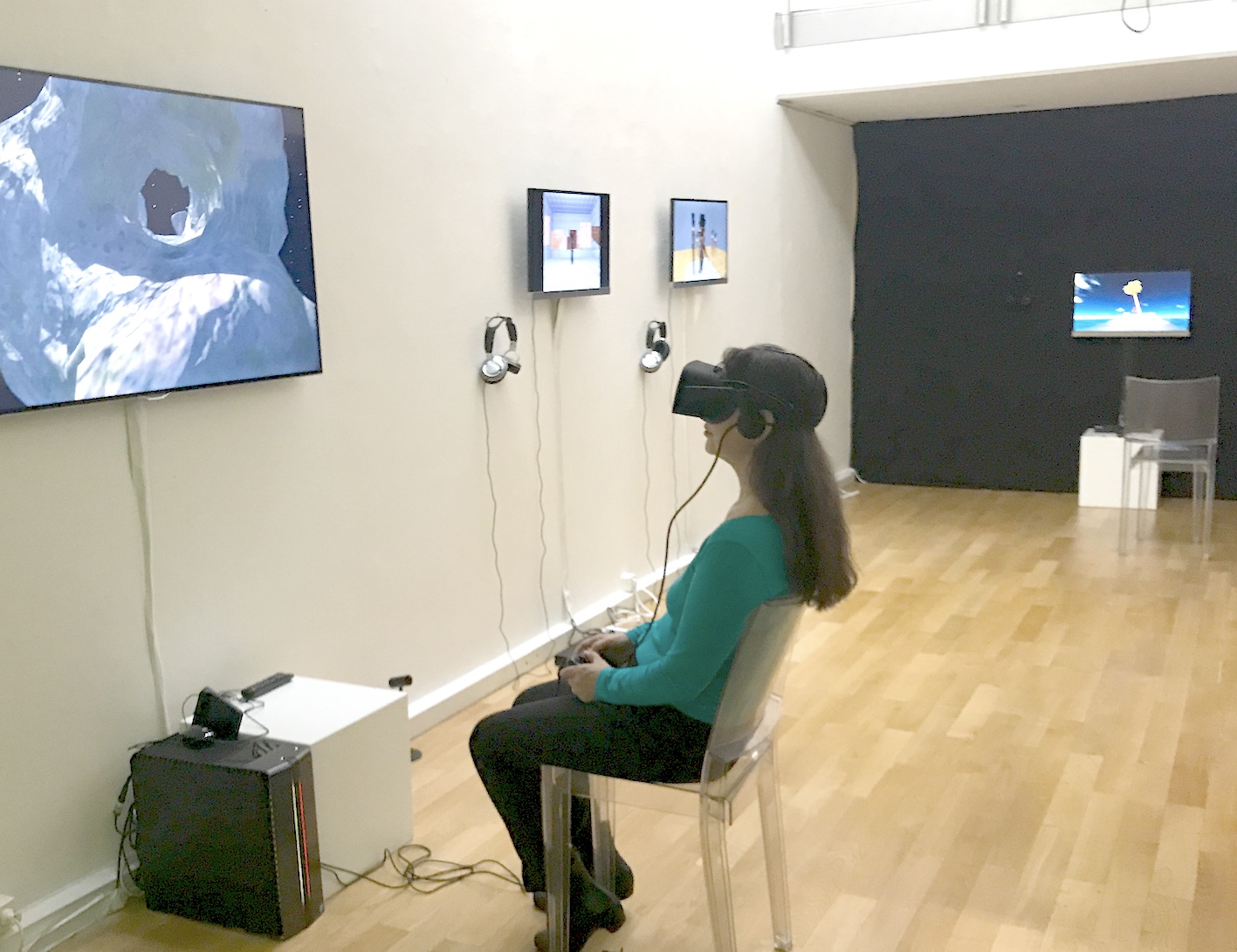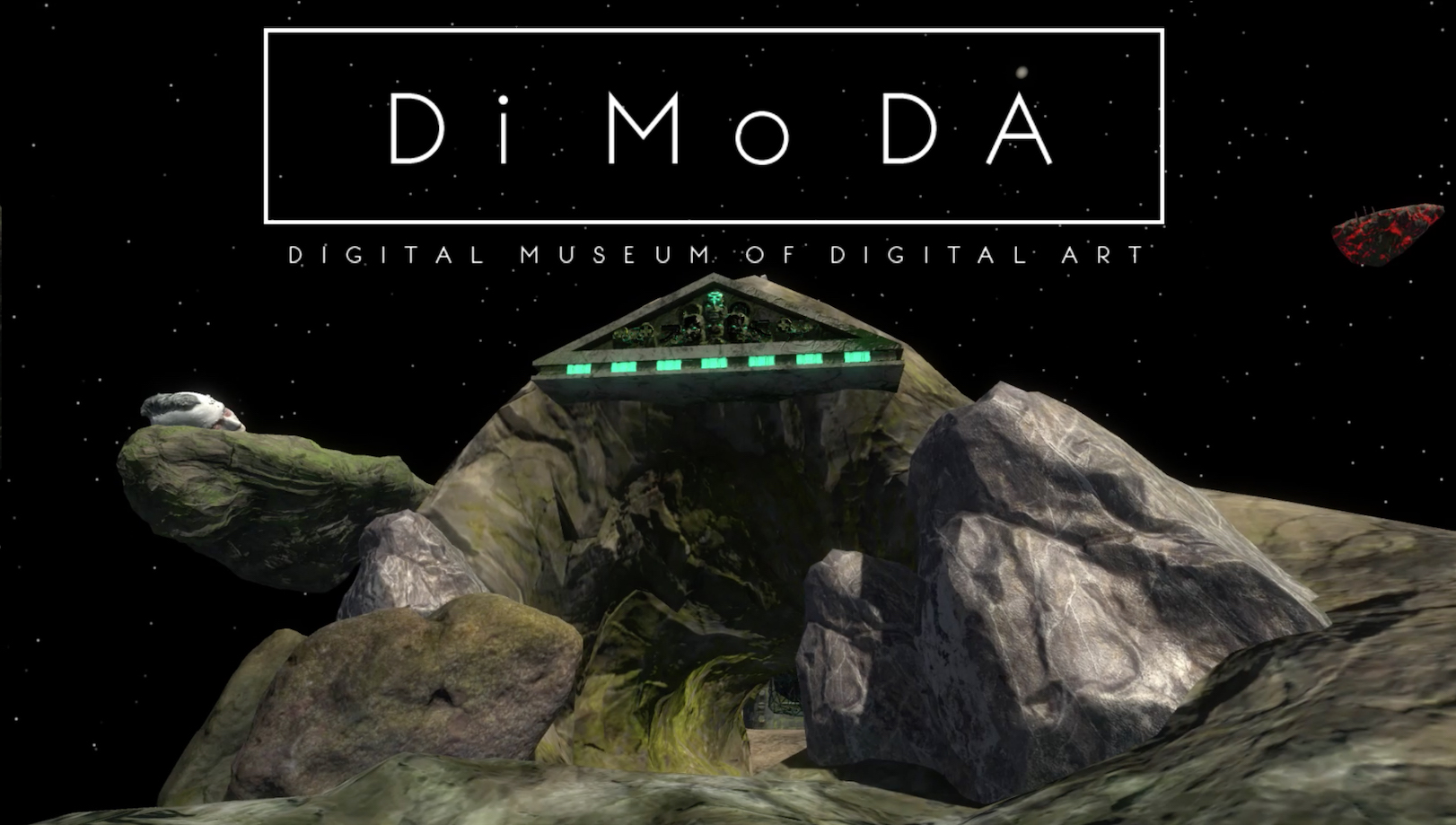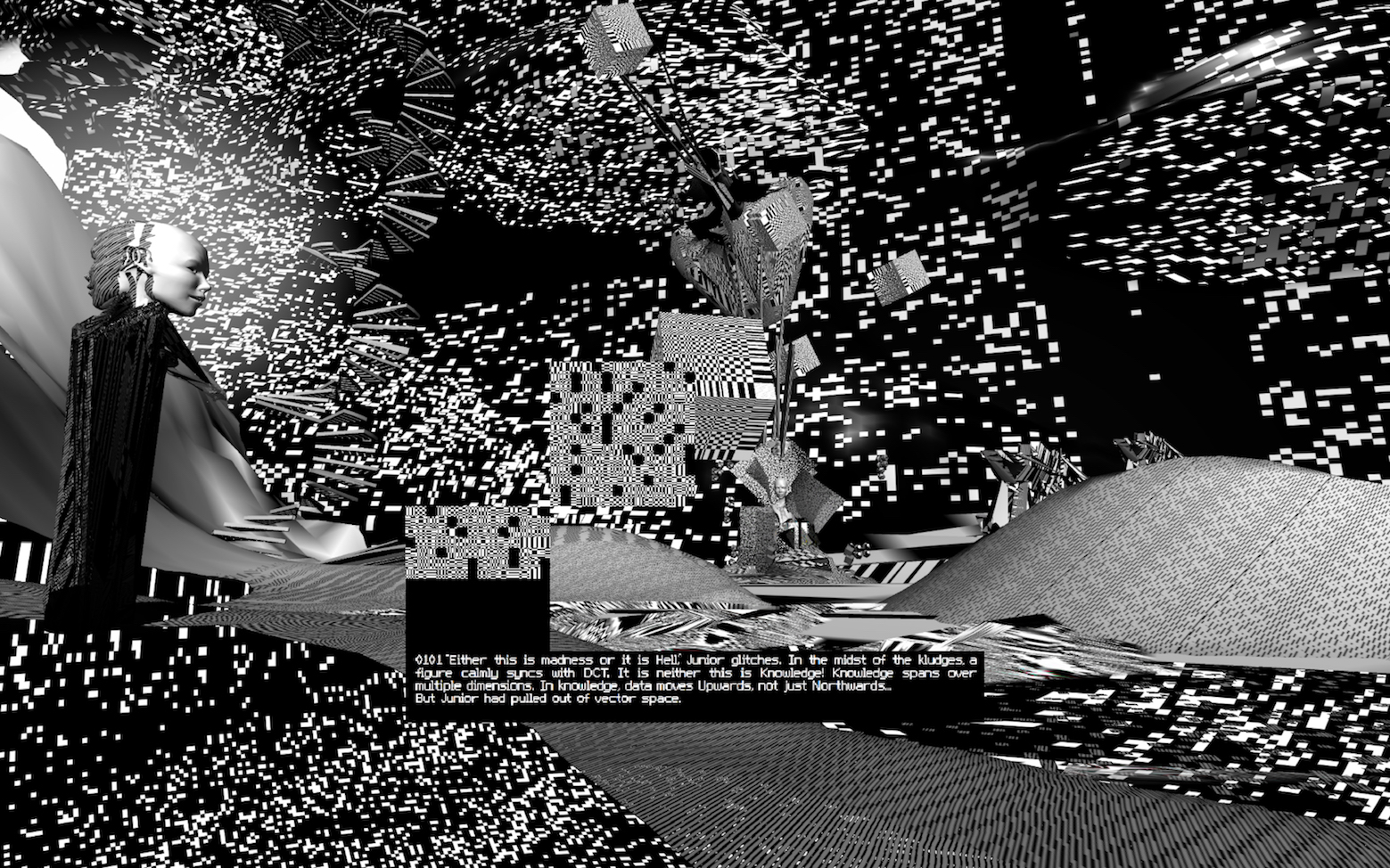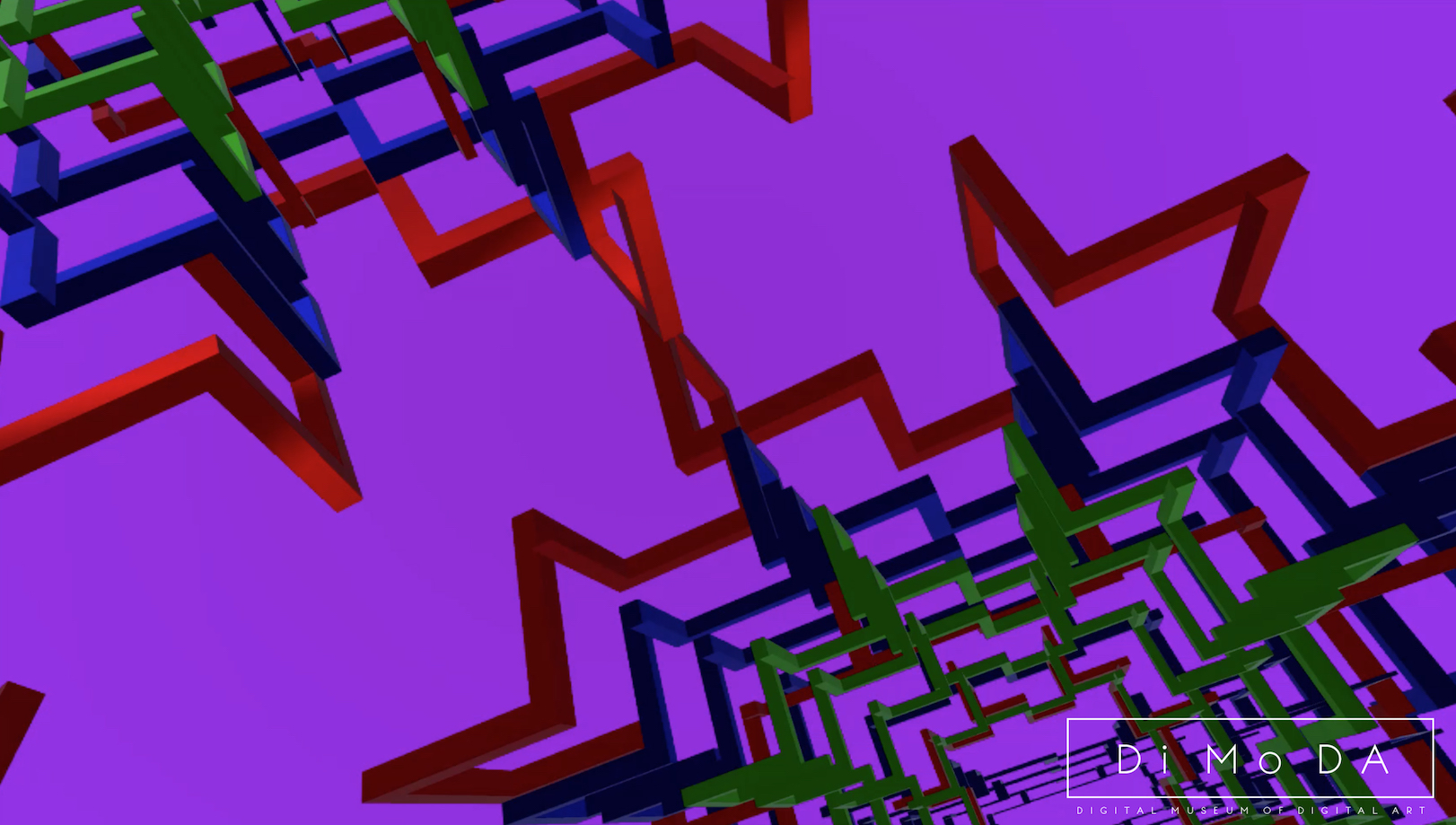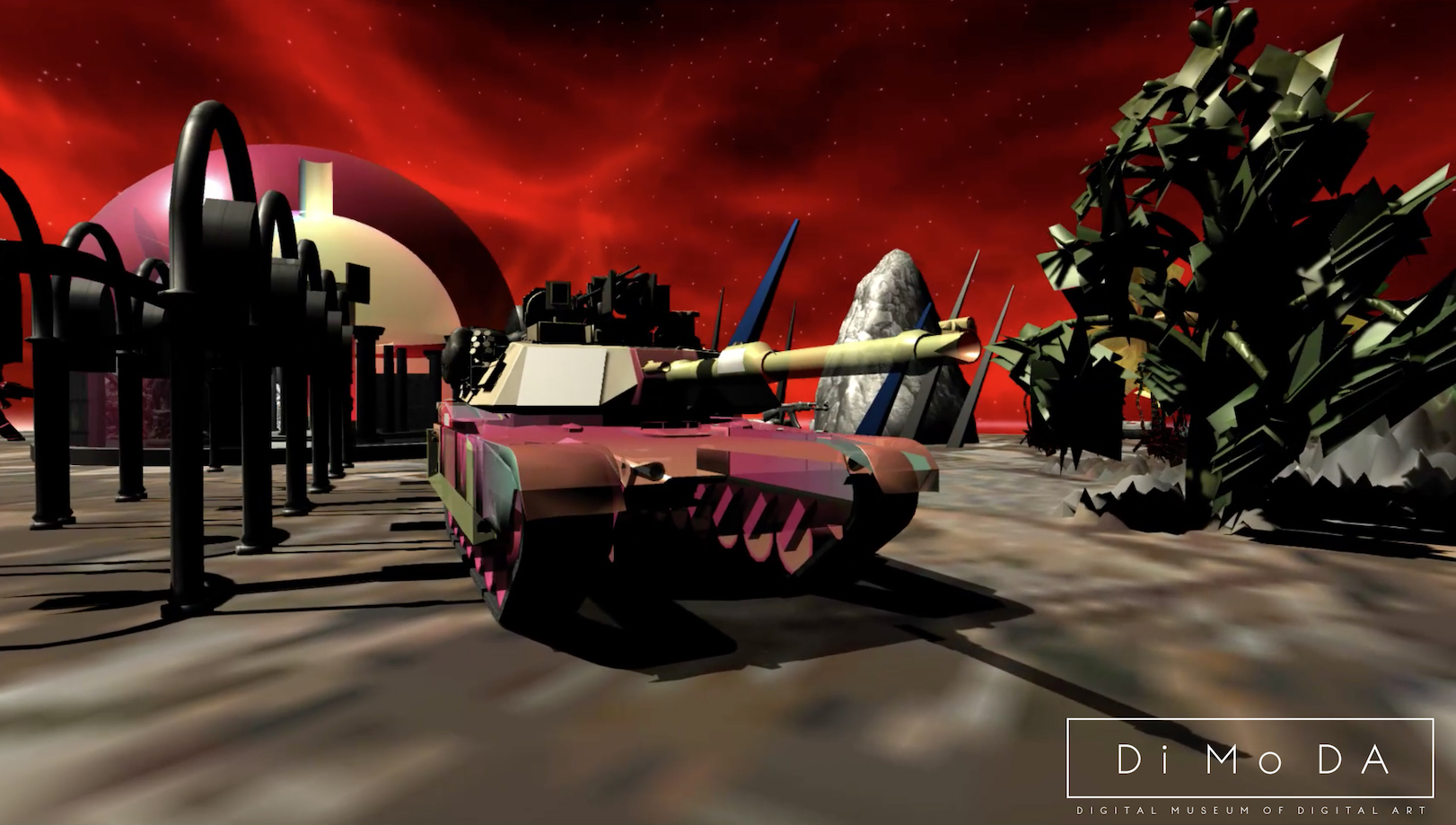RESET III and VIRTUAL REALITY
Documentation film of the exhibition
Artists: Gazira Babeli (IT), Friedemann Banz & Giulia Bowinkel (DE), Dominik Halmer (DE), Carla Mercedes Hihn (ROU/DE), Claudia Larcher (AUT), Patrick Lichty (US/UAE), Judith Sönnicken (DE), The Swan Collective (DE), Tamiko Thiel (JP/DE), Fiona Valentine Thomann (FR/DE) & Alfredo Salazar-Caro’s (MEX/US) and William Robertson’s (US) Digital Museum of Digital Art with the exhibition Morphé Presence curated by Helena Acosta (US) and Eileen Isagon Skyers (PH/US), with works by Rosa Menkman (NL/DE), Brenna Murphy (US), Theo Triantafyllidis (GR/US), Miyö Van Stenis (VEN/FR)
Curated by Tina Sauerländer (peer to space)
At: PRISKA PASQUER, Albertusstr. 18, 50667 Cologne, Germany
Duration: September 9 – October 28, 2017
With Virtual Reality (VR) a fundamental change is taking place in the digital age. Through the VR glasses people enter a new world instead of only looking at it on a flat screen. The human pursuit of immersion already demonstrated within the chambers of Egyptian pyramids, frescoed rooms of the Renaissance, or huge cinema walls is now seemingly fulfilled by virtual reality. A new era of the virtual space has begun. The exhibition RESET III and VIRTUAL REALITY illuminates the artistic exploration of virtual spaces against the background of the digital age. How do artists create virtual spaces? How do they compare to real environments? How does VR affect the body and perception? The RESET exhibition series initiated by | PRISKA PASQUER | deals with the development of art in the digital age in different artistic media. It examines how artists react to the challenges and possibilities of digital transformation.
Gazira Babeli, Come Together, 2007, Installation view by Nathan Ishar © the artists, courtesy of the artist and PRISKA PASQUER, Cologne
Meaning and definition of the virtual space are subject to constant change, and it is entering a new phase with the advent of today's virtual reality technology. A virtual space is not only an illusionary space on a surface but an immersive world, revealed in Virtual Reality (VR). The difference is that with the VR-glasses or Head-Mounted Display (HMD), a person does not look at another world from the outside anymore but is located right in the middle of it. The viewer is the center of the environment and decides where to look or go. He senses proportions and perceives the virtual world three-dimensionally in the round.
The artists presented in the exhibition RESET III and VIRTUAL REALITY deal with the production of space in the digital age in various media. This includes the virtual spaces of immersive interactive large-scale projections (Tamiko Thiel), performances and exhibitions in Second Life (Gazira Babeli and Patrick Lichty), or augmented Reality works that enrich the real space digitally over a screen (Banz & Bowinkel, Fiona Valentine Thomann). The exploration of virtual spaces in the mirror of the digital also takes place in all other contemporary media, e.g. sculpture (Claudia Larcher), mixed-media wall installations (Carla Mercedes Hihn, Judith Sönnicken) or painting and installation (Dominik Halmer). The exhibition presents VR artworks by Banz & Bowinkel, The Swan Collective, Fiona Valentine Thomann as well as the Digital Museum of Digital Art by Alfredo Salazar-Caro and William Robertson. It is a virtual reality museum, currently presenting the exhibition Morphé Presence, curated by Helena Acosta and Eileen Isagon Skyers, with works by Rosa Menkman, Brenna Murphy, Theo Triantafyllidis and Miyö Van Stenis.
Banz and Bowinkel, Palo Alto, 2017, artistic VR experience © Banz & Bowinkel, courtesy of the artist and PRISKA PASQUER, Cologne
INFORMATION ABOUT EACH ARTWORK:
Gazira Babeli (Second Life, 2006-2010) was an avatar in Second Life (SL) and performance artist there. She dealt with concepts of physicality and identity in the virtual space and was at the same time a work of art and an artist. In her Group Sculpture Performance Come Together, naked avatars performed together and their bodies digitally merged. GAZWORK (2006/2007) is a video documentary of Gazira Babeli running in the style of Buster Keaton. The character of Gazira Babeli can be described as a complex assemblage full of references to the digital world, the real world and art historical themes that examines the behavior of avatars in Second Life as well as cultural contexts from real life.
Dominik Halmer, Works from: Semi-Athletics, Installation view by Nathan Ishar © the artists, courtesy of the artist and PRISKA PASQUER, Cologne
The artist duo Banz & Bowinkel (Giulia Bowinkel: *1983 in Düsseldorf, lives and works in Düsseldorf, Friedemann Banz: *1980 in Mainz, lives and works in Düsseldorf) examines the conditions of materials and substances in the digital space and its relation to physical laws valid on the earth. In their VR experience Palo Alto, the viewer finds himself on a labyrinth-like plateau with a tower he or she can climb after passing through an underground corridor. At the very top, he stands under a pendulum that points to either "true" or "false". Thus describes the world of virtual reality, which is illusionist but at the same time perceived as real by the human body. Palo Alto is driven by the notion that the virtual world is not the sphere of simulated reality, but its counterpart, in which the computer subjects the meaning of our society to a new order as an unconscious force.
Dominik Halmer (*1978 in Munich, lives and works in Berlin) questions the structure and perception of reality in his so-called semi-functional image objects. Poetically, he confronts the classical concept of painting with playful functionality and everyday objects; e.g. sports equipment in its series Semi-Athletics. In doing so, he confronts different levels of reality, from different forms of painting to real objects. As part of the collage, the objects continue the painterly gesture and become an element of the spatial installation. In the post-internet age, we perceive the works by Dominik Halmer - like other visual information – through reproductions on the Internet. On the two-dimensional photographs of the artist’s spatial installations the layers merge so that it is hardly possible to see which real objects the artist used in his installations or which ones he painted.
Claudia Larcher, PANORAMA #3, 2012 and Carla Mercedes Hihn, Umbruch, Swing and Arada, all 2012, Photo by Nathan Ishar © the artists, courtesy of the artist and PRISKA PASQUER, Cologne
In her site-specific works, Carla Mercedes Hihn (*1981 in Hermannstadt, Romania, lives and works in Berlin) deals with the nature and diaphanous structures. She combines dynamic drawings with collages on transparent substrates such as glass, windows or doors. They intertwine with the real environment of the place like an analog version of Augmented Reality, changing the light situation and having an effect on the space. At the same time the daylight changes the work. The shadows of the transparent works that lean against the wall influence the perception of the work itself.
Gazira Babeli and Patrick Lichty, 7UP!, 12 Second Life Performances, 2007 © the artists, courtesy of the artists and PRISKA PASQUER, Cologne
The panorama by Claudia Larcher (*1979 in Bregenz, lives and works in Vienna) consists of collaged images from architectural magazines, which she brought together and then created a new form out of them with a uniform surface. In order to experience the work, the viewer stands within the sculpture that hangs from the ceiling. Standing in the circular Panorama, the viewer perceives his environment through this kind of mask, which becomes an analog version of Augmented Reality. He is surrounded by the work and therefore becomes the center (as in Virtual Reality) and perceiving the work not only from the outside, but from the inside as well. The artwork and its environment merge to create a new perspective.
Judith Sönnicken, Migraine Mountains, 2012, Installation view by Nathan Ishar © the artist, courtesy of the artists and PRISKA PASQUER, Cologne
Patrick Lichty (*1962, lives and works in Abu Dhabi, UAE) has been a media “reality” artist, curator, and theorist for over two decades who explores how media and mediation affect our perception of reality. His work centers on the axiom of mediation creating realities. In Second Life, his avatar named Man Michinaga performed together with Gazira Babeli. The video 7UP! includes 12 performances like Marchmallows (Avatar-Lined Teacup), On The Road Never Again or The Hansen-Ono Piano Method 1.0. Using the remote control of the DVD player, the viewer clicks through the various performances. Patrick Lichty's Avatar Man Michinaga and Gazira Babeli belong to Second Front, a group of avatars in Second Life, who organized a series of meetings to do performances inspired by the Fluxus movement, the Futurists or the Dadaists in front of the eyes of an audience.
The Swan Collective, NowForeVR, 2016, Virtual Reality Experience, © the artists, courtesy of the artists and PRISKA PASQUER, Cologne
Migraine Mountains by Judith Sönnicken (*1981 in Wickede/Ruhr) consists of a mountain landscape originally painted in slow-drying oil, matching the geological, non-human time in which mountains form. The painting was digitally transformed into a red/green 3D version and printed onto two superimposed acrylic glass plates. The green layer is motorized and moves in slow circular motion. The piece references the stereoscopic method used to generate spatial depth by assigning a color to each of the brain’s hemispheres. The artist says: “The moment I ascend the mountain, being exposed to its high altitude, half of my head twinges and distorts my perception of it. The perspective shifts, vanishing points occur within the mineral density, and it becomes so enormous in size that I loose visual grip. I feel an analogy between the shifting plates that created the mountain, and the hemispheric dissonance, accelerated, in my own head.”
The basis for NowForeVR by The Swan Collective (founded in 2007) are acrylic paintings, transferred by the artist collective around Felix Kraus (*1986 in Munich, lives and works in Berlin) into Virtual Reality. There, the viewer can be physically immersed in the architectural spaces and develop a feeling for the depth, size and solidity of the buildings. Since the images determine the surface texture of the virtual architecture, the viewer is exclusively in hand-painted rooms.
Tamiko Thiel, The Travels of Mariko Horo, Immersive interactive installation, 2006, Photo by Nathan Ishar © the artist, courtesy of the artist and PRISKA PASQUER, Cologne
Tamiko Thiel (*1957 in Oakland, California, lives and works in Munich) deals in her interactive and immersive installations with the interplay between place and physicality as well as cultural identity and its historical development. In the interactive installation The Travels of Mariko Horo, the user aka Mariko Horo undertakes a fictional journey from Japan to the foreign and exotic West sometime between the 12th and 22nd century. During the fantasy journey through time and space, mythological and religious worlds of the different cultures interfere and overlap. The work was inspired by Japanese artists who created a version of the West from their imagination. Mariko's version also reflects the history of the "hidden Christians" in Japan who secretly revered statues of Kannon, the Buddhist goddess of mercy, as the Christian Madonna, because Christianity was forbidden under the pain of death at that time. Further the structure of The Travels of Mariko Horo refer to Dante's Divine Comedy as well as on the Buddhist cosmology, so that the visual language is inspired by Byzantine frescos as well as by Tibetan tankas.
Fiona Valentine Thomann, Tracker, Augmented Reality, 2017 © the artist, courtesy of the artist and PRISKA PASQUER, Cologne
Fiona Valentine Thomann (*1987, lives and works in Colmar, France, and Berlin) creates the work Tracker, a 3D model, similar to a physical sculpture, freely drawn by the artist in the digital space. The Trackers are collages on mirrors. Their Augmented Reality version is accessible by scanning the collages with the smartphone. At first glance Tracker looks abstract, but then reveals a variety of references to the current digital culture, from the wheel of human skin color made by Neil Arbisson, the first cyborg that only sees black and white and listens to color, to the Canadian company Vitalic’s pure oxygen bottles ready to be sent to China for 20 dollars per bottle. In the Virtual Reality version of Tracker the dimensions change once more. The viewer finds the Tracker and himself in outer space. The work consists of the first 360 degree video of outer space by NASA, filmed on the ISS (International Space Ship). The artist has recorded the sound of breathing through an oxygen bottle using the app Astronaut VR. This raises the question of exactly where the human body is in virtual reality.
The Digital Museum of Digital Art by Alfredo Salazar-Caro (*1989 in Mexico City, lives and works in New York City) and William Robertson (*1989, lives and works in Chicago) is a virtual museum for Oculus Rift. The current exhibition Morphé Presence is curated by Helena Acosta (*1981 in England, lives and works in New York) and Eileen Isagon Skyers (*1991 in Manila, Philippines, lives and works in Brooklyn, NY) with works by Rosa Menkman (*1983 in Arnhem, Netherlands, lives and works in Berlin), Brenna Murphy (*1986 in Edmonds/Washington, lives and works in New York), Theo Triantafyllidis (*1988 in Athens/Greece, lives and works in Los Angeles) and Miyö Van Stenis (*1989 in Caracas, Venezuela, lives and works in Paris).
The exhibition Morphé Presence points to VR being made of code and not real material, but creating a direct experience by quite literally influencing physical virtues or capabilities. The exhibition indicates the power and failure of technology when attempting to describe or frame reality. The work DCT: SYPHONING (2015/16) by Rosa Menkman tells the story of the two algorithms DCT senior and DCT junior on their odyssey through different compression stages of images. The artist points ironically to the increasingly complex, digital world where hardly anyone really understands how algorithms work. The name DCT (discrete cosine transformation) forms an important algorithmic component of JPEG image compression, but only a few people know about its functioning or are aware of gender or race implications that accompany the history of its development. In Miyö's War Room (2016) the artist Miyö Van Stenis explores the archetypical, political-ideological structures of Western society. Her virtual world refers to the first-person shooter game Doom (1993), whose success is supposedly based on the fact that it has brought war, death and destruction into our living rooms. In Miyö's War Room the user enters a strip club and reaches the "feminist cocktail", a video with speeches of influential women with hardcore porn juxtaposed. For the artist, this "poetic image" is based on the fact that sex or war are not individual wishes but serve as patriarchal instruments of power. In Brenna Murphy's Vectoral ~ Sentience_Stack (2016) the viewer finds himself in an abstract-geometric, psychedelic lattice structure. The three-dimensional and labyrinth-like sculptural landscapes are computer-generated and consist of ornaments from different cultures. They are reminiscent of pictorial elements of the Mayas or Incas as well as the hippie era. The artist translates them into the digital field and merges them together. In his Self Portrait (Interior) (2016), Theo Triantafyllidis explores the extended possibilities of portrait depiction in the virtual space. The user is located in front of an oversized, distorted and whitishly overcoated head of the artist, which lies on a white ground. The extended tongue serves as an entrance into the interior of the artist. There the viewer goes on a tour through the pink fleshy cave to the organs, thoughts, wishes and fears of the artist.
Theo Triantafyllidis, Self Portrait (Interior), 2016, Virtual Reality Experience © the artist, courtesy of the artist and DiMoDA
Rosa Menkman, DCT: SYPHONING, 2015/16, © the artist, courtesy of the artist and DiMoDA
